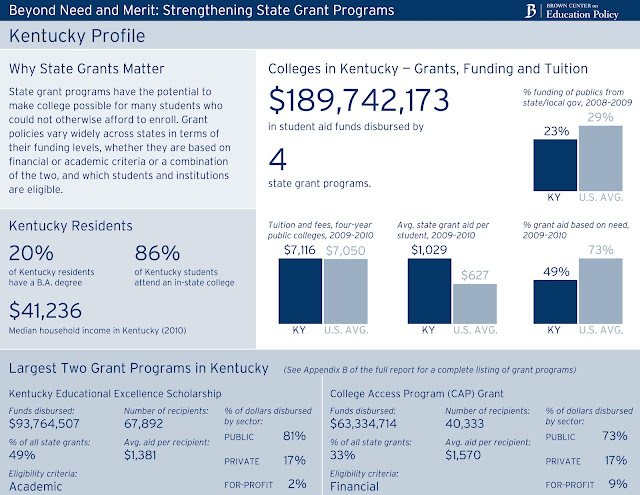This from the Brookings Institution with an interactive map:
Rising college tuition levels—accelerated by cuts in state funding for public universities— have combined with today's tough economic realities to make financing a postsecondary education even more difficult for students and their families. State grant programs are more important than ever to make college possible for many students who could not otherwise afford to enroll.
For these dollars to make as much difference as possible in the lives of students and in the future of state economies, state grant programs must be designed to produce the largest possible return on taxpayers' investment. In this report, the Brookings Institution State Grant Aid Study Group, chaired by student aid expert Sandy Baum, examines the variety of state grant programs currently in place and makes policy recommendations based on the best available research.
The group proposes moving away from the dichotomy between “need-based” and “merit-based” aid and instead designing programs that integrate targeting of students with financial need with appropriate expectations and support for college success. Here are highlights from their recommendations:
Help students with financial need
• To maximize the impact of their financial aid programs, states should do a better job of targeting aid dollars at students whose potential to succeed is most constrained by limited resources.
• Students whose options are constrained by limited resources are most likely to be affected by state grant awards—in terms of both their ability to attend college and the likelihood that they will graduate.
Consolidate and simplify
• States should consolidate programs to make the system simpler and easier for prospective students and their families to understand and navigate.
• Programs can be better targeted but still relatively simple. Look-up tables like those that would base grant eligibility only on income and family size might serve as a model.
• States should welcome federal simplification efforts and should resist any temptation to collect additional data—restoring complication even as the federal government reduces it.
• States should create a single net-price calculator that students can use to calculate the cost of attendance at every public institution in the state.
Design programs that encourage timely completion
• To encourage on-time degree attainment, state grant programs should reward concrete accomplishments such as the completion of credit hours.
• Academic requirements embodied in state grant programs should provide meaningful incentives for success in college; they should not be focused exclusively on past achievement or be so high as to exclude students on the margin of college access and success.
• States should provide second chances for students who lose funding because they do not meet targets the first time around.
Improving state grant programs in difficult financial times
• Rationing funds is unavoidable and there may be no good options under these circumstances, but some choices are worse than others. Providing assistance to those who apply early and denying aid to those who apply after the money has run out is quite arbitrary, particularly if an application deadline cannot be specified in advance.
• States under pressure to reduce their budgets quickly could lower income limits; cut grants for all recipients, with the neediest students losing the least; or build more incentives for college completion into their programs.
• States should use this time of financial exigency to carefully evaluate the effectiveness of existing grant programs and put in place systems for periodic review of these programs.
• In addition to tweaking their existing programs, states should test and evaluate innovative approaches. A pilot program found to be very successful could then be scaled up and replace another program found to be less effective.

No comments:
Post a Comment